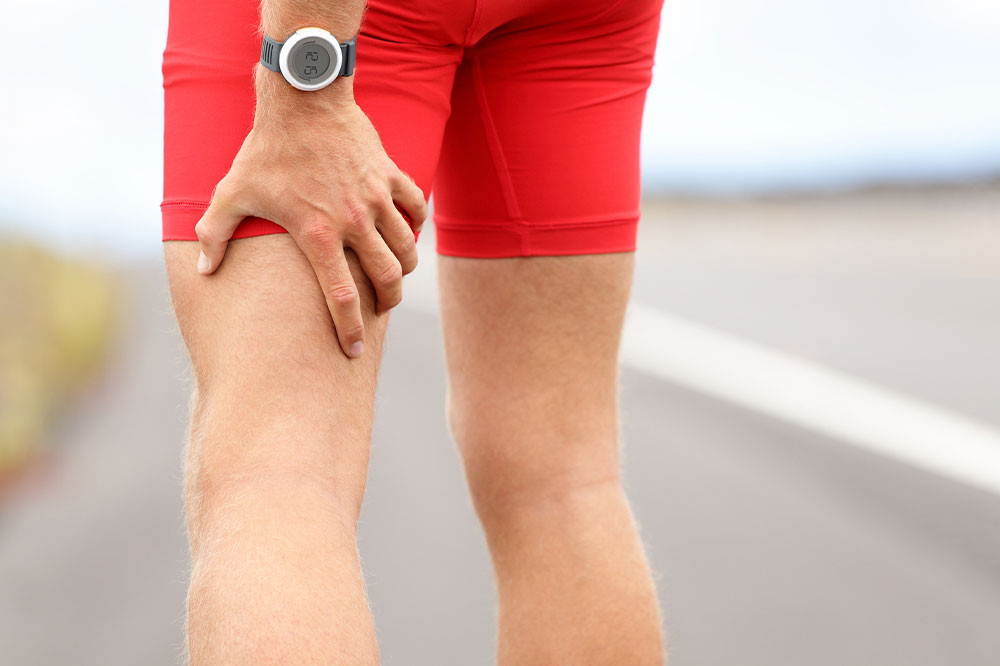
Hamstring injury – Signs, causes, and management
A hamstring injury occurs when you pull or strain one or more of the three hamstring muscles that run across the back of the thigh. It causes a lot of pain, making it difficult to perform routine activities. Hamstring injuries are common in athletes, especially those who play football, basketball, soccer, and other sports involving sprinting with sudden starts and stops. Read on to learn about the condition’s causes, symptoms, and treatment options.
Symptoms
You might experience different symptoms depending on how severe the injury is:
- Grade 1: A simple strain in the hamstring muscle can lead to sudden and radiating pain in the back of the thigh. It may not affect your strength but will make it hard to move your leg.
- Grade 2: A partial tear in the muscle causes more pain and may lead to bruising, swelling, and loss of leg strength.
- Grade 3: A severe tear in the hamstring muscle causes even more pain, along with bruising, swelling, and tenderness. You might experience a popping sensation when the injury occurs.
Besides experiencing these symptoms, you can tell if you have had a hamstring injury if you suffer from muscle spasms, feel like a knot or bump is present in the thigh area, and notice muscle stiffness.
Causes
The hamstring comprises a group of three muscles running along the back of the thigh from the hip to just below the knee. These muscles help extend the leg backward and bend the knee. Overusing or stretching any of these muscles beyond their limit might result in an injury.
Some risk factors associated with a hamstring injury include:
- Prior hamstring injury: People who have experienced a hamstring injury in the past are likely to develop another. It is particularly true for those who resume the same activities before the muscles heal.
- Sports: Activities that demand running or sprinting increase the risk of a hamstring injury. Besides sports, activities that need extreme stretching, like dancing, can also increase the risk.
- Muscle imbalance: Some doctors suggest muscle imbalance might lead to a hamstring injury. If the quadricep muscles located at the front of the thigh are more developed or stronger than the hamstring muscles, the latter is more likely to be strained.
- Tired muscles: Weak muscles or muscles that do not stretch well are more susceptible to this injury. Typically, muscles with poor flexibility fail to bear the pressure some activities need.
- Age: The risk of injury is more with advancing age.
Treatments and recovery
The treatment for a hamstring injury depends on the symptoms’ severity. Except for severe cases, doctors treat the condition non-surgically. Here, we take a closer look at both non-surgical and surgical options.
Non-surgical remedies
You can get rid of acute hamstring injuries at home using the RICE protocol that involves the following:
- Rest: Patients should avoid indulging in strenuous physical activity.
- Ice: Using a cold compress can help overcome inflammation and pain.
- Compression: It involves using the compression bandage to prevent tissue bleeding, avoid tear expansion, and reduce swelling.
- Elevation: It is a technique to relieve swelling and pain. Patients lift the leg above the heart to shift the blood flow away from the leg.
For more severe injuries, you might need to immobilize the knee and keep the leg in a neutral position using a knee brace. You can treat the pain using treatments recommended by the doctor. After the injury stabilizes and the swelling and pain reduce, it is safe to begin physical therapy that involves gentle stretching. Doctors may also recommend exercises to increase leg strength and muscle mass.
Surgical options
Hamstring avulsions demand surgery to reattach the rupture. Avulsions typically occur near the pelvis but may also develop near the shinbone. The surgeon may advise waiting three days to let the recoiled muscle relax in case of an acute rupture. Delaying beyond 72 hours is usually not advisable as the muscle might form extensive scarring.
Tendon avulsions, or cases where the tendon has entirely detached from the bone, also demand surgical intervention and a comprehensive recovery regimen. During a tendon avulsion repair procedure, the surgeon restores the hamstring muscles to their original location and removes any scar tissue present at the ruptured end.




